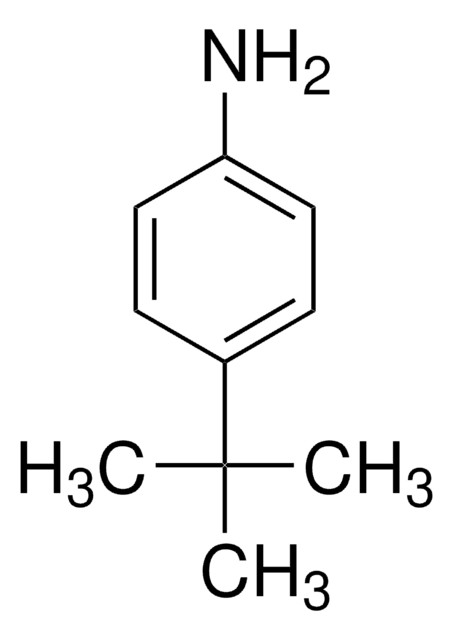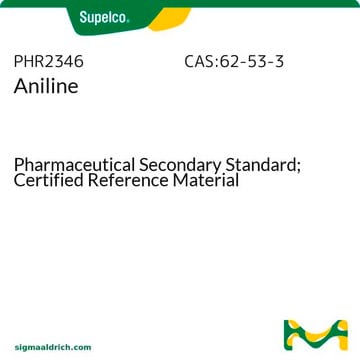推薦產品
蒸汽密度
3.22 (185 °C, vs air)
品質等級
蒸汽壓力
0.7 mmHg ( 25 °C)
產品線
ReagentPlus®
化驗
99%
形狀
liquid
自燃溫度
1139 °F
expl. lim.
11 %
折射率
n20/D 1.586 (lit.)
pH值
8.8 (20 °C, 36 g/L)
bp
184 °C (lit.)
mp
−6 °C (lit.)
溶解度
water: soluble
密度
1.022 g/mL at 25 °C (lit.)
SMILES 字串
Nc1ccccc1
InChI
1S/C6H7N/c7-6-4-2-1-3-5-6/h1-5H,7H2
InChI 密鑰
PAYRUJLWNCNPSJ-UHFFFAOYSA-N
尋找類似的產品? 前往 產品比較指南
一般說明
苯胺是一种芳香胺。它是一种重要的工业中间体,广泛用于制备染料、橡胶、树脂和聚合物。已经报道了苯胺及其氘化形式(苯胺-NHD和苯胺-ND2)的完全振动分配。1据报道,p-氨基二苯胺(ADPA)是苯胺电聚合过程中的主要中间体。据报道,其粘度在30℃为3.1457cp。采用功能化等离激元Au/TiO2光催化剂和Ag助催化剂对硝基苯向苯胺进行定量转化。在Cu、Ni、Pt、Pd和Au(催化剂)存在下,硝基苯发生氢化制备苯胺。也可以通过在WO3-Ag杂化纳米线存在下光催化还原硝基苯来制备。
應用
苯胺可用于制备偶氮苯。
生化/生理作用
苯胺的急性毒性涉及其在体内活化为4-羟基苯胺和与血红蛋白形成加合物。 在红细胞中,这与铁的释放和高铁血红蛋白的积累以及溶血性贫血和脾脏炎症的发展有关。长期给药时,在脾脏中常可观察到肿瘤形成。
物理性質
材料在储存期间颜色变暗,成为红棕色,但纯度不会受到影响。
法律資訊
ReagentPlus is a registered trademark of Merck KGaA, Darmstadt, Germany
訊號詞
Danger
危險分類
Acute Tox. 3 Dermal - Acute Tox. 3 Inhalation - Acute Tox. 3 Oral - Aquatic Acute 1 - Aquatic Chronic 1 - Carc. 2 - Eye Dam. 1 - Muta. 2 - Skin Sens. 1 - STOT RE 1
標靶器官
Blood
儲存類別代碼
6.1A - Combustible acute toxic Cat. 1 and 2 / very toxic hazardous materials
水污染物質分類(WGK)
WGK 3
閃點(°F)
158.0 °F - closed cup
閃點(°C)
70 °C - closed cup
個人防護裝備
Eyeshields, Faceshields, Gloves, type ABEK (EN14387) respirator filter
客戶也查看了
The application of fast scan cyclic voltammetry. Mechanistic study of the initial stage of electropolymerization of aniline in aqueous solutions.
Yang H and Bard AJ.
Journal of Electroanalytical Chemistry, 339(1), 423-449 (1992)
Atsuhiro Tanaka et al.
Chemical communications (Cambridge, England), 49(25), 2551-2553 (2013-02-21)
A functionalized plasmonic Au/TiO2 photocatalyst with an Ag co-catalyst was successfully prepared by the combination of two types of photodeposition methods, and it quantitatively converted nitrobenzene and 2-propanol to aniline and acetone under irradiation of visible light.
Photocatalytic hydrogenation of nitrobenzene to aniline over tungsten oxide-silver nanowires.
Fu L, et al.
Materials Letters, 142, 201-203 (2015)
Viscosities of Binary Mixtures of Benzyl Acetate with Dioxane, Aniline, and m-Cresol.
Katti PK and Chaudhri MM.
Journal of Chemical and Engineering Data, 9(3), 442-443 (1964)
Abdessamad Grirrane et al.
Nature protocols, 5(3), 429-438 (2010-03-06)
This protocol describes the aerobic oxidation of aromatic anilines to aromatic azo compounds using gold (Au) nanoparticles supported on TiO(2) as a catalyst. Yields above 98% are achieved under a few bars of oxygen pressure. It should be noted that
我們的科學家團隊在所有研究領域都有豐富的經驗,包括生命科學、材料科學、化學合成、色譜、分析等.
聯絡技術服務











